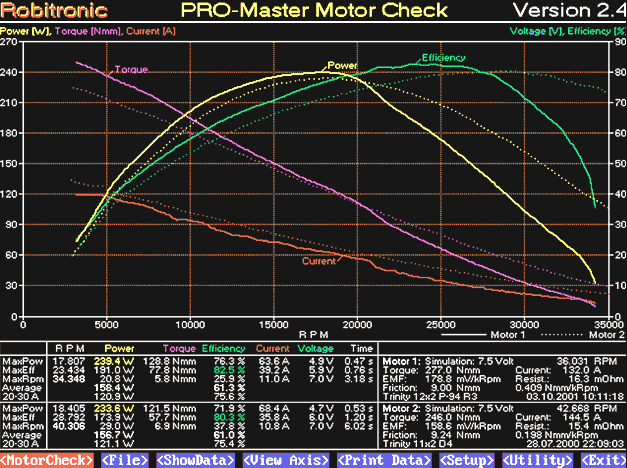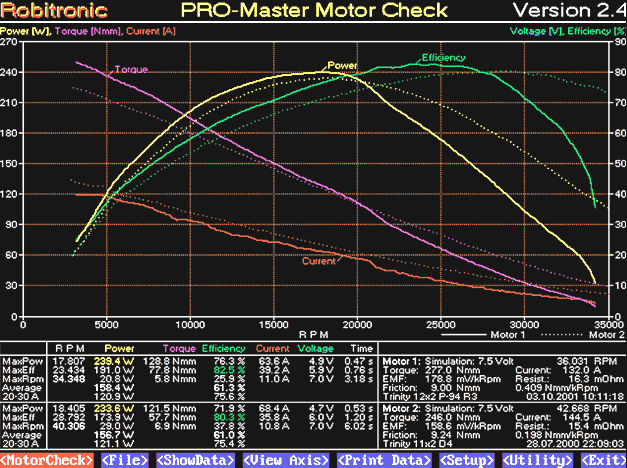|
Trinity
claimed, "We will change modified racing forever!" Its splashy
teaser ads for the new P-94 mod motor grabbed everyone's attention;
what was the story with this motor? People even folded the ad in
half like an Al Jaffee Mad fold-in to see whether there were any
clues hidden in its ambiguous "radiation" logo. Surely, the new
motor would be a radical departure from the mod motors with which
we're all familiar—right? Not so—at least, at first glance.
The P-94 doesn't jump out as a motor that will "change modified
racing forever," but when you take a closer look at the details and,
as we did, strap one into a dyno, we think you'll agree that it just
might be the next step in motor evolution that Trinity promised.
|
 |
P-94
Features
• Larger brush face designed for optimum
contact with commutator.
• Extra set of proprietary brushes
included.
• Pattern-wound "featuring Jim Dieter's favorite
winds."
• Stronger FB9 magnets.
• Silver-soldered comm
tabs.
| |
DYNO
TESTING
According to Trinity's team drivers, a 12-turn P-94 feels
like a standard-brush 10-turn motor, so I decided to compare my 12-turn
test P-94 with an 11-turn D4.
The number that most people look at is power in watts. "Power" in
electric motors is like horsepower in a nitro engine: more is better. The
P-94 clocks in with a more than healthy 239.4 watts of power compared with
the D4's 233.6 watts. Torque is rated at 128.8 Newton millimeters with a
very good efficiency rating of 82.5 percent, compared with 121.5 Nmm and
80.3 percent for the 11-turn D4.
What you can't see on the dyno is something Trinity claims is one of
the big advantages of the P-94—less need to rebuild. Because of the
brushes' larger contact patch, there is less pressure on the comm per
square millimeter, and the larger brushes reduce harmful arcing. Trinity
says the team drivers have been testing the new brushes for months and
have found that the comm requires less maintenance. That's a big bonus for
racers who don't have a comm lathe or simply don't want to cut the brushes
after every other run.
To test Trinity's claims, I tore down the P-94 that we ran in the Team
Losi Matt Francis Edition Triple-XT (reviewed in the January 2002 issue).
Sure enough, the comm was far cleaner than I expected after the number of
packs that the motor went through.
| DYNO DATA
|
|

Test results
Peak rpm
Peak power
(watts)
Peak torque (Nmm)
Peak efficiency (%)
|
34,347
239.4
128.8
82.5
|
Test-setup
specs
Wind
Brushes
Springs
Comm diameter
Timing
|
12 double
Stock
Purple (stock)
7.51mm
22
degrees
|
|
|
INSIDE THE P-94
The P-94's main feature is
its brush size: they're larger. Oversize brushes aren't new, but Trinity's
engineers say they've found the ideal size—larger than the current
standard but smaller than the oversize brushes tried in the past; it
measures 4.45x5mm (width x height); the old brush measures 5x5mm. The new
brush is also designed to reduce "cogging," which Trinity defines as
"dead
spots in the commutating cycle when one of the three poles is not
energized"; Trinity claims this is most pronounced in standard brush
systems. Moving to a wider brush reduces the likelihood of cogging, but if
a brush is too wide (as Trinity says the 5mm brushes are), the brushes
will short one of the commutator's poles—not good. Either scenario will
reduce efficiency and power, but with a 4.45mm brush, the cogging effect
is eliminated, but there is no shorting, and that means maximum power and
efficiency—if you believe Trinity's engineers. The dyno tells the real
story. The brushes are the big story, but the P-94 isn't just the D4 with
new brushes. Trinity dropped in FB9 magnets, which are claimed to be the
strongest TDK has produced. The P-94 has silver-soldered comm tabs,
layered winds and vented cans for higher turn motors to increase rpm.
|
 |
 |
| BIG BRUSH
ENVY |
It's easy to suffer from big-brush envy; after
all, they're bigger, deliver more power and last longer. But there's
no need to be envious; even if you can't afford a hand-wound P-94,
you can still enjoy the benefits of big brushes by getting a P-94
brush conversion kit (item no. RC4410; $12.99). It fits all Epic
can-based motors, and it delivers all the advantages the brushes
offer on the top-of-the-line P-94 series. I tested the kit on an
otherwise stock Zircon (9-double) Speed Gem motor to see just how
much performance there is to be gained.
When I compared the
data, my first reaction was "holy crap!" I really didn't expect such
a difference in performance just by installing the P-94 brush
conversion, but the dyno shows a staggering jump in power from 196
watts to 230.2 watts. For you math-impaired folks, that's a 34.2W
jump, or a 16.5 percent increase in power. There were also gains in
torque and efficiency; the big brushes work.


|
THE VERDICT
Does the P-94 "change modified
racing forever"? Although it does not represent the dramatic leap with
never-before-seen motor technology that some were expecting, the P-94 is
nonetheless a major advance in brushed motor performance. The new brushes
increase power and efficiency significantly and extend the time between
rebuilds. It's amazing what a few millimeters can do.
SOURCE GUIDE: Trinity Products Inc., (732) 635-1600; http://www.teamtrinity.com/.
|